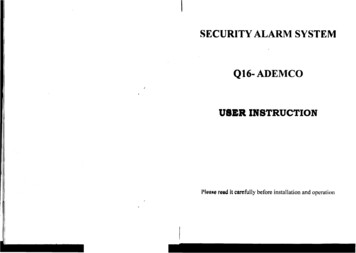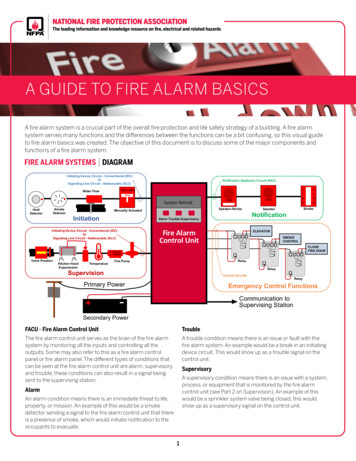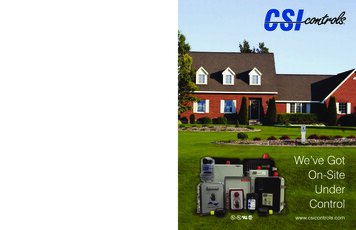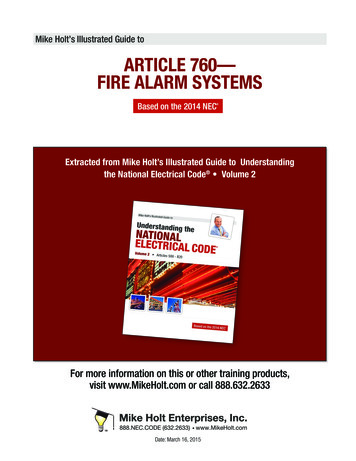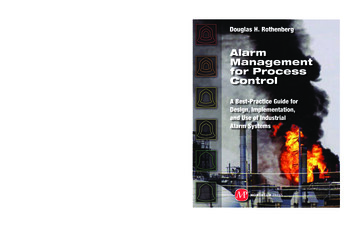
Transcription
Alarm Managementfor Process Controlby Douglas H. Rothenberg, Ph.D. Recommendations and guidelines are developed from fundamental concepts to provide powerful technical tools and workable approaches. Alarms are treated as indicators of abnormal situations, notsimply sensor readings that might be out of position. Alarm improvement is intimately linked to infrastructuremanagement, including the vital role of plant maintenanceto alarm management, the need to manage operators’ charterto continue to operate during abnormal situations vs. ceaseoperation, and the importance of situation awareness withoutundue reliance upon alarmsThe ability to appreciate technical issues is important, but this bookrequires no previous specific technical, educational, or experientialbackground. The style and content are very accessible to a broad industrial audience from board operator to plant manager. All criticaltasks are explained with workflow processes, examples, and insightinto what it all means. Alternatives are offered everywhere to enableusers to tailor-make solutions to their particular sites.“His book is a comprehensive treatment of thecurrent best practices in industrial process controlalarm management. Doug covers the entire alarmmanagement process from how to recognize thelevel of performance of existing systems throughthe methodology and procedures for redesigning(or designing new) state-of-the-practice alarmsystems. All critical tasks are explained, with examples and insight into what they mean.”—W. Boyes, Control MagazineContents:Introduction; PART I: Meet Alarm Management; Abnormal Situations; Strategy for AlarmImprovement; Alarm Performance; PART II:Permission to Operate; Alarm Philosophy; Rationalization; Enhanced Alarm Methods; PARTIII: Implementation; Life Cycle Management;Project Development; Situation AwarenessAbout the Author:Doug Rothenberg is founder and President of D-RoTH, Inc., a leading world-class consultingfirm in all areas of alarm management systems for industrial manufacturing and technologyproviders, based in Shaker Heights, Ohio. He holds a BSEE in Electrical Engineering fromVirginia Tech, a MSEE from Case Institute of Technology, and a Ph.D. in Systems Engineeringfrom Case Western Reserve University. He is past president of the Cleveland Instrumentation,Systems, and Automation Society and remains active in both regional and national engineeringand professional societies, including ISA and Sigma Xi. He serves on ISA 18 and API 1167alarm management standards committees.ISBN: 978-1-60650-003-390000www.momentumpress.net9 78 1 606 500033RothenbergAlarm Managementfor Process ControlThis book elevates alarm management from a fragmented collectionof procedures, metrics, experiences, and trial-and-error, to the levelof a technology discipline. It provides a complete treatment of bestpractices in alarm management. The technology and approachesfound here provide the opportunity to completely understand thewhat, the why, and the how of successful alarm systems.No modern industrial enterprise, particularly in such areasas chemical processing, can operate without a secure and reliableinfrastructure of alarms and controls—they are an integral part ofall production management and control systems. Improving alarmmanagement is an effective way to provide operators with high-valuesupport and guidance to successfully manage industrial plant operations. Readers will find:What Others are Saying“This book provides a thorough view of what ittakes to manage our alarms. But it is not just abook on alarm management; the underlying messages are about Safety and Awareness. It solidlyconveys the mantra that the most effective way torun a manufacturing site is this: Ensure employeesafety & provide a work environment that delivers the right amount of information at exactly theright time. The book contains details and insightthat can only be gained through experience, lessons learned, and problem solving. It is presentedfor those of us with an interest or desire for properalarm management, yet who do not know whereto start or how to sustain our progress.”—A. T. StumpDouglas H. RothenbergAlarmManagementfor ProcessControlA Best-Practice Guide forDesign, Implementation,and Use of IndustrialAlarm Systems
AlarmManagementfor ProcessControlimo-rothenberg-00fm.indd i10/4/10 11:40 AM
imo-rothenberg-00fm.indd ii10/4/10 11:40 AM
AlarmManagementfor ProcessControlA Best-Practice Guide forDesign, Implementation,and Use of IndustrialAlarm SystemsDOUGLAS H. ROTHENBERGMOMENTUM PRESS, LLC, NEW YORKimo-rothenberg-00fm.indd iii10/4/10 11:40 AM
Alarm Management for Process ControlCopyright Doug Rothenberg, 2009All rights reserved. No part of this publication may be reproduced, stored in a retrieval system, ortransmitted in any form or by any means—electronic, mechanical, photocopy, recording or any otherexcept for brief quotations, not to exceed 400 words, without the prior permission of the publisherFirst published in 2009 byMomentum Press , LLC222 East 46th Street, New York, N.Y. 10017www.momentumpress.netISBN-13: 978-1-60650-003-3 (hard back, case bound)ISBN-10: 1-60650-003-1 (hard back, case bound)ISBN-13: 978-1-60650-005-7 (e-book)ISBN-10: 1-60650-005-8 (e-book)DOI forthcomingCover Design by Jonathan PennellInterior Design by Scribe, Inc. (www.scribenet.com)First Edition March 20095 6 7 8 9 10Printed in Taiwan ROCimo-rothenberg-00fm.indd iv3/23/11 11:41 AM
To my dearest wife, constant companion, champion, and best friend, KatarzynaGustaw, under whose sheltering roof and within whose protecting walls the firstwords to this book, nearly the final words, and much in between were written.Książkę tą dedykuję mojemu najlepszemu przyjacielowi, drogiej żonie mojejKatarzynie Gustaw. Za jej to przyczyną i w jej przyjaznym domu pracowałemprzez długi czas, rozpocząłem i zakończyłem pisanie.imo-rothenberg-00fm.indd v10/4/10 11:41 AM
imo-rothenberg-00fm.indd vi10/4/10 11:41 AM
About the Authorouglas H. Rothenberg is the president and principalconsultant of D-RoTH, Inc., a technology consulting company providing innovative technology andservices for industry. His background includes 10 years as anindependent consultant to Fortune 1000 companies; over 20years with Standard Oil, BP Oil, and BP Amoco, where hewas responsible for new, state-of-the-art technology to support advanced manufacturing solutions; and 10 years in academia at Case Western Reserve University. Current areas ofspecialty with D-RoTH include alarm management, fit-forpurpose product design, and innovation development for newproducts and services.Rothenberg has a PhD in systems and control engineering from Case WesternReserve University, an MS in electrical engineering from Case Institute of Technology,and a bachelor of electrical engineering degree from Virginia Polytechnic Institute.He has several patents in instrumentation and controls. He is active in the Instrumentation, Systems, and Automation Society (ISA, formerly the Instrument Society ofAmerica) and a member of Sigma Xi, the Scientific Research Society. He is the recipient of 2005 Educator of the Year Award from Cleveland Technical Societies Council,Cleveland, Ohio.Dviiimo-rothenberg-00fm.indd vii10/4/10 11:41 AM
imo-rothenberg-00fm.indd viii10/4/10 11:41 AM
ContentsAbout the AuthorList of FiguresList of t a HandbookAudienceUsefulnessContentsPart I: The Alarm Management ProblemPart II: The Alarm Management SolutionPart III: Implementing Alarm ManagementBook DeliverablesImportant iixliixliiixliiixliiixlivxlivxlivPart 1: The Alarm Management Problem1Chapter 1: Meet Alarm Management31.1 Key Concepts1.2 Alarm Performance ProblemsSymptomsEvidence1.3 Reasons for Alarm ImprovementHow Alarms Fit into Process Operating SituationAlarm dd ix10/4/10 11:41 AM
Contents Chapter 11.4 A Brief History of Alarm Management1.5 The “Management” in Alarm Management1.6 Alarm Design Roadmap1.7 Audience for this Book1.8 Importance of Alarm Management1.9 Fundamentals of Alarm ManagementBottom Line of Alarm ManagementFundamentalsOperator ActionImportance of the Fundamentals1.10 Design for Human Limitations1.11 Alarm Management and Six Sigma1.12 Controls PlatformsPLC versus DCSPLC Special Considerations1.13 Continuous versus Discrete and Batch1.14 Application Effect on Alarm Design1.15 Time and Dynamics1.16 Historical IncidentsThree Mile IslandMilford HavenTexas CityWhy Now?1.17 The New DesignNot by Subtraction AloneStarting Alarm ImprovementAlarm PhilosophyData Gathering and AnalysisAlarm Conventions and Redesign Guidelines1.18 Example Alarm Redesign (Rationalization) Results1.19 Completing the DesignAdvanced TechniquesSituation AwarenessOperator Screen DesignOperational Integrity ImprovementCondition fm.indd x10/4/10 11:41 AM
Contents Chapter 21.20 Alarm Improvement Projects1.21 Lessons for Successful Alarm Management1.22 Important Design and Safety Notice1.23 Conclusion1.24 Notes and Additional ReadingNotesRecommended Additional ReadingChapter 2: Abnormal Situations2.1 Key Concepts2.2 Introducing Abnormal SituationsTwo ScenariosThe Two Sides of Abnormal Situations2.3 Observing Abnormal Situations2.4 Understanding Abnormal Situations2.5 Understanding IncidentsGeneral Concepts LearnedYour Plant Data2.6 General Lessons from IncidentsExamination for CauseHazards Defined by the FAATwo Events2.7 Critical Contributors to IncidentsSubtle AbnormalitiesThe Human Nature of OperatorsStop in Time2.8 The Importance of TimeAn ExampleProcess Safety TimeSUDAAlarm Activation Point and Time2.9 Why Abnormal Situations Are Important2.10 Message of Abnormal SituationsState of Control LoopsThe Magic in a Control LoopAbnormal Situations in fm.indd xi10/4/10 11:41 AM
Contents Chapter 32.11 Notes and Additional ReadingNotesRecommended Additional Reading737373Chapter 3: Strategy for Alarm Improvement753.1 Key Concepts3.2 How We Got Ourselves into TroubleControls Technology EvolutionHow We ThinkThe Way Forward3.3 The Alarm Management ProblemSymptomsRoot CausesA Good AlarmSo Many Alarms, So Little TimeBenefits of Rationalization3.4 Alarm Activation Path3.5 The Geography of Alarm ManagementPlant Area ModelSmallest Area of Rationalization3.6 Alarm Improvement TeamsRepresentationLocal TeamsSite TeamLarge Corporate Team3.7 Alarm Improvement Projects3.8 Standards and Regulations OverviewBest Practices SummaryKey MessagesGuides, Standards, and Regulations3.9 Proposed RegulationsDepartment of Transportation (United States)3.10 Standards and GuidesEEMUA 191NAMUR (Germany)ISA 93949494959698xiiimo-rothenberg-00fm.indd xii10/4/10 11:41 AM
Contents Chapter 4OSHA (United States)HSE (UK)EPRI (United States)Remarks3.11 Conclusion3.12 Notes and Additional ReadingNotesRecommended Additional ReadingChapter 4: Alarm Performance4.1 Key Concepts4.2 Alarm Problems4.3 Alarm Performance Assessment4.4 Alarm Metrics and BenchmarksWhy Have Metrics?Plant Area of Focus—A Single-Operator AreaBasic Configuration MetricsBasic Activation Metrics4.5 Alarm Assessment ToolsWhy Use a Tool?Characteristics of Good ToolsTool ProvidersGetting the Data InConfiguration DataActivation Data4.6 Configuration Analysis4.7 Activation AnalysisActivation Analysis across Industrial SegmentsDeriving Implications from Activation AnalysesAcknowledgment RatioTime to AcknowledgeTime to ClearAlarm FloodChattering and RepeatingRelated and ConsequentialStanding and 122123123xiiiimo-rothenberg-00fm.indd xiii10/4/10 11:41 AM
Contents Chapter 4Nuisance Alarms (Bad Actors)4.8 Advanced Activation Analysis4.9. Alarm Correlation AnalysesSituationsGeneral Comments4.10 One Day in the Life of an Alarm System—ConfigurationNumber of Tags and Tags with AlarmsNumber of Alarms by Alarm TypePriority of Configured AlarmsDuplicate Alarms4.11 One Day in the Life of an Alarm System—ActivationThe Raw DataAmount of Data Produced in One DayAlarm ActivationsTime in AlarmTime to AcknowledgeOperator Actions4.12 Alarm System Performance Levels4.13 Conclusion4.14 Notes and Additional ReadingNotesRecommended Additional 35137137139140140140141Part 2: The Alarm Management Solution143Chapter 5: Permission to Operate1455.1 Key Concepts5.2 Management’s Role5.3 Operating SituationsOperating in UncertaintyUnique EventsExplosive EventsDefinitions5.4 How Permission to Operate Came to Be5.5 How Permission to Operate 00fm.indd xiv10/4/10 11:41 AM
Contents Chapter 55.6 Permission to Operate5.7 Alternative Methods for Granting PermissionDe Facto DecisionsOperating Modality Decisions5.8 Managing the Operator’s PermissionQualifying AbnormalNo Help at HandObserver EvaluationOperator EvaluationPutting It All Together5.9 Shut Down and Safe ParkOperator-Initiated ShutdownAutomated ShutdownSafe Park5.10 Special TechnologyDetection and Warning of Abnormal ConditionsConditions Related to the PlantConditions Related to the Operator5.11 Operator Redeployment5.12 Process ComplexityLinearly Related ComplexityIntegrated/Complex Related5.13 Training and SkillsIndustrial ManufacturingMilitary Training5.14 Other Key Principles of OperationAdditional Operating PrinciplesField PrinciplesSafety System PrinciplesDesign and Inspection PrinciplesManagement Principles5.15 What Is Being Done by OthersTechnology in Development5.16 Conclusion5.17 9169169170xvimo-rothenberg-00fm.indd xv10/4/10 11:41 AM
Contents Chapter 6Chapter 6: Alarm Philosophy6.1 Key Concepts6.2 CaveatsA Foundation Is at the BottomOwner versus DesignerReliance on PhilosophyCompleteness6.3 Getting StartedOperator SurveyAdvice to the Reader on Timing of This Topic6.4 Special Alarm IssuesTypes of Alarms and Their Recommended UseSmart Field DevicesLight BoxesSpecial Cases of Redundant AlarmsAbout AlertsClasses of Alarms6.5 Overview of Alarm PhilosophyPhilosophy 101Operator-Centric ItemsPlant-Centric ItemsAlarm System PurposePhilosophy IntentElements in the Philosophy6.6 Alarm PriorityPriority LevelsPriority NamesHumorous Illustration of PriorityConsequence and SeverityUrgencyPriority AssignmentAlarm Priority Assignment Setup Review6.7 Enterprise Philosophy FrameworkOverviewFramework Philosophy DocumentAt the Enterprise 2193194196196xviimo-rothenberg-00fm.indd xvi10/4/10 11:41 AM
Contents Chapter 6Factoring It All into the Philosophy6.8 Site-Level PhilosophySite PersonalityThe Rest of the “Bases”6.9 Alarm Design PrinciplesFundamental PrinciplesFunctional PrinciplesKey Performance IndicatorsCritical Success FactorsApproved Management of Change RequirementsProcedure for RationalizationAlarm Configuration: Specific IssuesAlarm Activation Point DeterminationPriority AssignmentAlarm PresentationOperator RolesInterplay with ProceduresTrainingEscalationMaintenance6.10 Example Procedure: To Silence or to Acknowledge6.11 Philosophy Hit List6.12 Alarm Philosophy WorkshopWorkshop DetailsFacilitationPreparation6.13 Enterprise Philosophy Framework6.14 Conclusion6.15 NotesChapter 7: Rationalization7.1 Key Concepts7.2 IntroductionBasic ApproachesCornerstone Concepts of Alarm Management7.3 About the Word indd xvii10/4/10 11:41 AM
Contents Chapter 77.4 Checklist7.5 Getting Ready to RationalizeHousekeepingBad ActorsFilters and DeadbandsThe DataAlarm Documentation and Rationalization ToolsRationalization Is Not Just About Numbers7.6 Alarm Response ManualHeader InformationConfiguration DataCausesConfirmatory ActionsConsequences of Not ActingAutomatic ActionsManual Corrective ActionsSafety-Related Testing RequirementsExample Online Alarm Response SheetAdditional Items7.7 Rationalization MethodsAlarms Are Not the Important PartRationalization Approaches“Starting from Where You Are” Rationalization“Starting from Zero” Rationalization7.8 Required Alarms and Common ElementsRequired AlarmsCommon Elements7.9 “Starting from Where You Are” RationalizationWork Process7.10 “Starting from Zero” RationalizationWork ProcessWrap-Up7.11 Only Four Alarms7.12 Identifying Subsystem BoundariesDecomposition7.13 “Starting from Zero” 7249249251251256xviiiimo-rothenberg-00fm.indd xviii10/4/10 11:41 AM
Contents Chapter 7FurnaceHeat Exchanger7.14 Working Through the DatabaseMethod of FlowsMethod of ElementsChoosing a Method7.15 The Alarm Activation PointAlarm Activation Point DeterminationA Digression in Setting Alarm Activation PointsThe Limit of Alarm LimitsGeneralizing Alarm Activation Point CalculationsToo Much Time; Just Enough TimeAlarm “Pick-Up” Order7.16 Determining Alarm PriorityAssigning PriorityCalibrating the Alarm Priority Assignment ProcessNonweighted Maximum Severity withUrgency Direct to Priority7.17 Alarm Priority Assignment ExamplesSum of All SeveritiesSum of All Severities Weighted by UrgencyMaximum SeverityUrgency OnlyMaximum Severity Weighted by UrgencySummary of Examples7.18 Rationalization Working SessionsTeamsParticipant PreparationWork AreasWork SessionsEvents Schedule7.19 Partial RationalizationsConcepts and ExperienceBad ActorsRationalize Only Important Parts of theOperator’s 294294xiximo-rothenberg-00fm.indd xix10/4/10 11:41 AM
Contents Chapter 8Rationalize Only Alarms that ActivateBottom Line7.20 Conclusion7.21 Notes and Additional ReadingNotesRecommended Additional ReadingChapter 8: Enhanced Alarm Methods8.1 Key Concepts8.2 Beginning8.3 The Situation8.4 Safety NoticeOperator AwarenessMonitoringUnsafe Operations8.5 Enhanced Alarm Functions8.6 Enhanced Alarm InfrastructureGeneral ConsiderationsAlarm ProcessorsBasic InfrastructureEnhanced InfrastructureAlarm Integrity Monitoring8.7 Operator ConsentImplement AutomaticallyImplement Unless CancelledSuggest with Positive Response RequiredSuggest Only8.8 Operator-Controlled Suppression Techniques8.9 Preconfigured, Simplified Suppression Techniques8.10 Informative AssistanceWhen Informative Assistance Is UsefulHow to Do ItExamplesMore Examples8.11 Knowledge-BasedPattern RecognitionNeural 5316318319320321xximo-rothenberg-00fm.indd xx10/4/10 11:41 AM
Contents Chapter 9Fuzzy LogicKnowledge-Based ReasoningModel-Based Reasoning8.12 Keeping Track of Plant StateExplicit Plant StatesImplicit Plant States8.13 Alarm Information without Alarm ActivationPlant Area ModelConditional Alarming Facilitators8.14 Alarm Activation PermissionsCategory I AlarmsCategory II AlarmsCategory III Alarms8.15 Conclusion8.16 Notes and Additional ReadingNotesRecommended Additional 33333333Part 3: Implementing Alarm Management335Chapter 9: Implementation3379.1 Key Concepts9.2 Beginning9.3 Implementation StepsApprovalsConfigurationEnhanced Alarm FeaturesProcess Graphics and Other ureOperability ReviewFinal Approval9.4 ImplementationSimulators and TrainingCutover and 43343xxiimo-rothenberg-00fm.indd xxi10/4/10 11:41 AM
Contents Chapter 10Moving On9.5 ConclusionChapter 10: Life Cycle Management10.1 Key Concepts10.2 Assess Alarm PerformanceInitial AssessmentPeriodic AssessmentTiming of AssessmentsCollection of DataEvery Alarm Activation Points to Opportunity10.3 Interpretation of Periodic AssessmentsEvaluateLook for Added BenefitsModify and RepairMonitor and EnforceNuisance AlarmsAlarm CreepAdding and Removing Alarms10.4 Advanced Interpretation of Periodic AssessmentsNomenclature and DesignValueCases10.5 Statistical Process Control and Alarm ManagementBackgroundRelevance to Alarm ManagementGuidance10.6 EnforcementEnforcement by ShiftPeriodic EnforcementAperiodic Enforcement10.7 NotesChapter 11: Project Development11.1 Key 9371372xxiiimo-rothenberg-00fm.indd xxii10/4/10 11:41 AM
Contents Chapter 1111.2 The Fit of Alarm Improvement11.3 The Business CasePercentage of Daily LossesDirect CalculationNegotiationBottom Line11.4 Project Design ApproachesAlarm Improvement by Starting from Where You AreAlarm Improvement by Starting from ZeroUsefulness of Stages11.5 Project Construction AlternativesSitewide, ComprehensiveSitewide, StagedSitewide, Unit-by-Unit, ComprehensiveReview11.6 Why Some Projects Fail11.7 “Low-Hanging” Fruit11.8 ConclusionChapter 12: Situation Awareness12.1 Key Concepts12.2 Operator Support NeedsThe HatThe Disaster ChainNeed for Situation AwarenessVisualizations12.3 The Deviation Diagram12.4 User-Centered Design—Human FactorsHuman Factors lityImplementabilityUnified 398399xxiiiimo-rothenberg-00fm.indd xxiii10/4/10 11:41 AM
Contents Chapter 1212.5 Our Biological Clock12.6 Other Operator Support IssuesIntent RecognitionOperator VigilanceTo Push or to Pull12.7 Operator DisplaysPhysical Display ArchitectureModern DisplaysHierarchical Display ArchitectureThe Overview LevelThe Secondary LevelThe Tertiary Level12.8 Navigation12.9 Notifications Instead of Alarms12.10 Perception Problems with Video DisplaysRelationships and SizeCoding ConflictsColorComments12.11 New Operator Display DesignCoding Schemes and IconsOverview LevelSecondary LevelTertiary LevelDo ASM-Style Displays Work?12.12 Wrap-Up12.13 Notes and Additional ReadingNotesRecommended Additional ix 1: Definitions of Terms, Abbreviations,and Acronyms439Appendix 2: Twenty-Four Hours of Alarms452Appendix 3: Operator Alarm Usefulness Questionnaire501A3.1 Operator Alarm Usefulness Questionnaire502xxivimo-rothenberg-00fm.indd xxiv10/4/10 11:41 AM
Contents AppendicesExplanationPurposeGeneral InstructionsConfidentialitySurveyorsAdditional Information If You Have QuestionsWhere Questionnaire Is to Be ReturnedOperator Alarm Usefulness QuestionnaireNormal Steady OperationPlant Faults and TripsGeneralA3.2 Quiet Period Alarm Usefulness QuestionnaireExplanationInstructionsColumn DefinitionsSurvey Data 7517517518519Appendix 4: Alarm Philosophy fromHoneywell European Users521Appendix 5: Overview of Alarm Managementfor Process Control537A5.1 The ChaptersPart I: The Alarm Management ProblemPart II: The Alarm Management SolutionPart III: Implementing Alarm Management538538541544Appendix 6: Alarm Response Sheet547Appendix 7: Metrics and Key Performance Indicators549Part I: Recommended Requirements for Analysis ToolsA7.1 PurposeA7.2 BackgroundA7.3 Analysis TypesA7.4 QueriesA7.5 Alarm Remediation ndd xxv10/4/10 11:41 AM
Contents AppendicesA7.6 Tools and Key FeaturesPart II: MetricsA7.7 IntroductionA7.8 Static (Configuration) MetricsA7.9 Dynamic (Activation) MetricsAppendix 8: Alarm Management PioneersA8.1 Opening NotesFather of Modern Alarm ManagementA8.2 Alarm Management TaskforcePioneering MembersObjectives for WorkA8.3 Abnormal Situation Management ConsortiumKey PlayersObjectives for WorkA8.4 Additional CreditsStandards and Practice OrganizationsTrainers and ConsultantsServices ProvidersTechnology ProvidersIndustrial Controls ProvidersPersonalities at LargeA8.5 NoteAppendix 9: Qualitative Risk Method for Priority AssignmentAcknowledgmentA9.1 Qualitative RiskA9.2 Porter’s Discussion on the Rationales for theQualitative Risk Matrix for Alarm PrioritizationGoalScopeA9.3 Description of MatrixProbability AxisSeverity AxisA9.4 Definition of 578578xxviimo-rothenberg-00fm.indd xxvi10/4/10 11:41 AM
Contents AppendicesAppendix 10: Manufacturing Modalitiesand Alarm ManagementA10.1 IntroductionA10.2 Characteristics of Manufacturing ModalitiesA10.3 Comparison MatrixAppendix 11: Notifications ManagementA11.1 IntroductionA11.2 Points to ConsiderA11.3 Questions and henberg-00fm.indd xxvii10/4/10 11:41 AM
FiguresFigure 1.0.1. Alarms are an intrusive notification to the operatorFigure 1.3.1. Operating region versus modality of remediationFigure 1.3.2. Aging workforce in U.S. power industryFigure 1.6.1. Alarm redesign roadmapFigure 1.9.1. Alarm design foundation fundamentalsFigure 1.9.2. Operator action typesFigure 1.15.1. Magical viewer stageFigure 1.15.2. Looking into our processFigure 1.16.1. The iceberg of alarm managementFigure 1.17.1. Number of alarm occurrenceswithin last 30 days (by frequency)Figure 1.17.2. Example of an alarm floodFigure 1.17.3. Typical alarm priority spreadFigure 1.17.4. Link between alarms and actions (3 months)Figure 2.3.1. What an abnormal situation looks likeFigure 2.4.1. Incident severity triangleFigure 2.6.1. Causes of incidentsFigure 2.8.1. Timeline of an explosive gas leakFigure 2.8.2. Process safety time and SUDAFigure 2.9.1. Mapping current productionFigure 2.9.2. Improved production through better process managementFigure 3.2.1. Exponential growth in configured alarmsFigure 3.2.2. Panel board semigraphicFigure 3.2.3. Engraved window for dedicated panel-mounted alarmFigure 3.3.1. Top ten reasons to rationalize your alarm systemFigure 3.4.1. Alarm activation pathFigure 3.5.1. Conceptual plant area 28385xxviiiimo-rothenberg-00fm.indd xxviii10/4/10 11:41 AM
FiguresFigure 3.6.1. Plant representation on alarm improvement teamsFigure 3.6.2. Process area alarm improvement teamFigure 3.6.3. Formation of a site alarm teamFigure 3.6.4. Formation of a corporate alarm teamFigure 4.4.1. BenchmarkFigure 4.5.1. Alarm tools examine dataFigure 4.5.2. PCS configuration import process for alarm toolsFigure 4.5.3. Example of a structured configuration database entry (TiPS)Figure 4.5.4. Real-time data import structure for toolsFigure 4.5.5. Example of structured real-time data (TiPS)Figure 4.7.1. Top twenty nuisance alarms versus total alarms (Matrikon)Figure 4.7.2. Plant locations for top twenty nuisance alarms (Matrikon)Figure 4.7.3. Problems remedied to remove toptwenty nuisance alarms (Matrikon)Figure 4.10.1. Duplicate configured alarmsFigure 4.10.2. Duplicate alarms using the configuration mapFigure 4.11.1. March 11 alarms per hourFigure 4.11.2. March 11 alarm activation by frequency of activation per tagFigure 4.11.3. March 11 time in alarmFigure 4.11.4. March 11 time to acknowledgeFigure 4.11.5. March 11 operator actionsFigure 4.11.6. March 11 operator actions versus alarm activationsFigure 5.3.1. Plant state versus operational modes and goalsFigure 5.7.1. Regions of operationFigure 5.8.1. Permission to operate diagramFigure 5.11.1. Typical control room operator arrangementFigure 5.11.2. Second operator develops a significant problemFigure 5.11.3. Operator deploymentFigure 5.12.1. Linearly related operating block unitFigure 5.12.2. Integrated/complex related block unitsFigure 6.3.1. Roadmap location for philosophyFigure 6.6.1. Procedure to set up rationalization priority matricesFigure 6.7.1. Enterprise alarm improvement team structureFigure 6.7.2. Iterative philosophy development processFigure 6.10.1. Process condition and silence and acknowledge 95209xxiximo-rothenberg-00fm.indd xxix10/4/10 11:41 AM
FiguresFigure 6.10.2. Process control system’s behavior for alarmsand acknowledge or silenceFigure 7.2.1. Rationalization on the alarm improvement roadmapFigure 7.2.2. Rationale for rationalizationFigure 7.5.1. Illustration of alarm deadband operationFigure 7.6.1. Example alarm response sheetFigure 7.6.2. Example of an online linked alarm response sheetFigure 7.7.1. Rationalization numerical results dependon rationalization approach usedFigure 7.9.1. Starting from where you are workflowFigure 7.10.1. Starting from zero workflowFigure 7.11.1. Pump and tower exampleFigure 7.12.1. Decomposition boundariesFigure 7.12.2. Transformational analysis diagramFigure 7.12.3. Transformational analysis diagram with incidentsFigure 7.12.4. Boundary attributesFigure 7.12.5. Key subsystem influencesFigure 7.13.1. Example furnace for alarmingFigure 7.13.2. Simple shell-and-tube heat exchanger instrumentationFigure 7.13.3. Simplified alarming for shell-and-tube heat exchangerFigure 7.14.1. Method of flows rationalization progressionFigure 7.14.2. Method of elements rationalization progressionFigure 7.15.1. Process safety timeFigure 7.15.2. Illustrations of alarm activation point calculationFigure 7.15.3. Alarm activation points compared to controller setpointFigure 7.15.4. Several alarm activations around the same timeFigure 7.15.5. Change in process safety time due to operator interventionFigure 7.15.6. Several alarm activations at the same timeFigure 7
1.6 Alarm Design Roadmap 12 1.7 Audience for this Book 13 1.8 Importance of Alarm Management 13 1.9 Fundamentals of Alarm Management 15 Bottom Line of Alarm Management 15 Fundamentals 15 Operator Action 17 Importance of the Fundamentals 18 1.10 Design for Human Limitations 19 1.11 Alarm Management and Six Sigma 19 1.12 Controls Platforms 21
